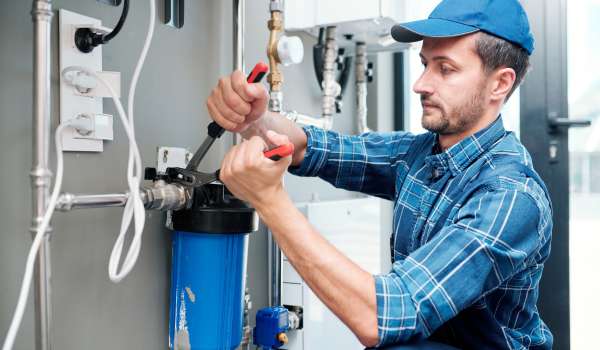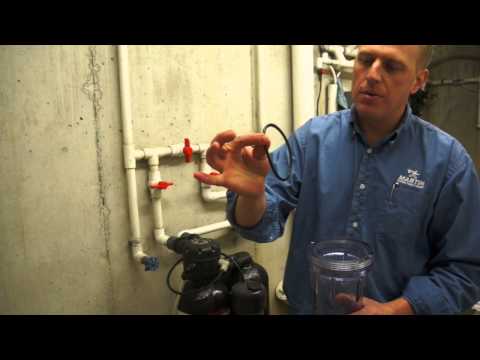Even the most reliable whole-house water filters can spring a leak — but the good news is, you probably don’t need to call in a plumber just yet.
In most cases, a few basic tools and a careful inspection are all it takes to stop the drip and get your system running smoothly again.
Whether your filter is outdated, over-pressurized, or just needs a little TLC, we’ll walk you through the most common causes — and exactly how to fix them step by step.
⚡ Quick Take: Why Filters Leak & How to Fix It
Common leak sources:
- Fluctuating water pressure
- Loose fittings or overtightened housings
- Cracked filter canisters or worn-out O-rings
How to fix it:
- Shut off the water supply
- Inspect cartridges, housings, and O-rings
- Replace damaged parts
- Restart the system and check for leaks
🧰 Bonus: You’ll also learn when to DIY — and when it’s time to call in the pros.
💧 Why Whole-House Water Filters Start Leaking

Even the most reliable systems aren’t immune to wear and tear. Leaks often start small — and in surprisingly common places. Before you panic, here are the usual suspects worth checking first:
- 🔩 Pipes & Fittings Connections between your plumbing and the system can loosen, especially after temperature swings or high water pressure.
- 🧃 Filter Cartridge A dirty, clogged cartridge can restrict flow and create backpressure — sometimes enough to crack the housing.
- 🧱 Filter Housing (Sump) These plastic canisters can loosen over time or crack under pressure. Sometimes it’s just a matter of tightening it by hand.
- 🧼 Gaskets & O-Rings These soft seals are easy to overlook, but they’re a common failure point. Dirt buildup, warping, or simple age can cause them to leak.
- 🧪 Softener Tubing & Valves In dual-tank systems, check the line between the brine and resin tanks — and make sure the valves are sealed properly.
💡 Helpful to Know:
Most leaks come from loose fittings, clogged filters, or tired O-rings — all things you can inspect and repair without hiring a plumber.
🧰 How to Troubleshoot a Leaking Cartridge-Based Filter
If you have a multi-stage system with replaceable cartridges, leaks usually come down to a few common issues. Here’s how to check each component — no plumber required.
🛠️ What You’ll Need:
- Filter wrench (plastic, not metal)
- Teflon tape
- Food-grade silicone grease
- Bucket and towel
- Spare cartridges
- Replacement O-rings or gaskets
🔍 Step-by-Step Checklist:
- 🔧 Shut off the water supply Turn off your home’s main line or use the filter’s bypass valve (if equipped). Not sure how? Here’s how to use a bypass valve.
- 📊 Check cartridge pressure If your system has pressure gauges, high readings often mean a clogged filter — which can increase strain and cause leaks.
- 💨 Release pressure Press the filter housing’s pressure release button if it has one. No button? Open a nearby faucet to relieve pressure before loosening the housing.
- 🔄 Remove the housing Use your plastic wrench to twist the filter housing counter-clockwise. Take out the old filter and inspect it for buildup or damage.
- 🕵️♂️ Inspect the filter media Look for discoloration, black flecks, or clogging. If it’s dirty or breaking down, replace it.
- 🔍 Check the housing itself Examine the threads and body for cracks — even hairline ones. Replace any damaged housing (don’t attempt to patch it with glue or epoxy).
- 🧪 Reassemble and test Hand-tighten everything (no wrench unless the manual says so), then turn the water back on gradually. Watch for drips as the system repressurizes.
- 🧼 Inspect the O-rings Look for dry spots, cracks, or compression. If damaged, swap them out and apply a light coat of silicone grease to keep the seal tight.
📌 Helpful to Consider: According to the EPA, cracked housings or worn components can reduce filtration effectiveness and allow contaminants through.
🛢️ Troubleshooting a Leaking Single-Tank or Softener System

Single-tank filters and water softeners are generally low-maintenance, but when a leak does pop up, it’s usually coming from the top of the unit — not the tank itself.
Before assuming the worst, here’s how to pinpoint what’s going on:
🧩 Step-by-Step Troubleshooting:
- 👀 Check for condensation first If your tank feels wet all over, it might just be condensation — not a leak. Cold water moving through a warm space can cause moisture to bead on the outside of the tank.
- 🧥 Use a tank jacket if needed Neoprene tank covers help prevent condensation. If you don’t have one, check regularly to distinguish between condensation and actual leaks.
- 🔧 Inspect the control head The most common leak source is the head at the top of the unit. Shut off the water (and power if it’s electronic), then carefully disassemble and inspect the valve, gasket, and O-ring.
- 🧪 Check brine tank (for softeners) If you have a salt-based softener, check the brine tank for cracks or pooling water.
- 🧼 Clean the venturi valve Clogs in the venturi valve — the part that draws saltwater into the softening tank — can cause overflows or leaks. Mineral buildup is a frequent culprit.
- 🔗 Examine the connector tubing Look for displaced or cracked tubing between the tanks. A small shift during maintenance can loosen a fitting and cause a slow leak.
💡 Good to Know:
Drips from the top often run down the side of the tank before pooling at the base — making it seem like the leak is coming from below. Always inspect from the top down.
🛡️ How to Prevent Whole-House Water Filter Leaks

The best way to deal with a leak? Prevent it in the first place. A well-installed and regularly maintained system can run trouble-free for years — and save you from costly water damage.
Here’s how to keep your system leak-free:
🔧 Installation & Maintenance Tips:
- Install a bypass valve If your filter didn’t come with one, it’s worth adding. It really makes servicing the system a heck of a lot easier — and keeps water flowing to your home during maintenance.
- Use the right filter wrench Stick with the plastic wrench that came with your system. Using a metal wrench (like one for car oil filters) can crack the housing threads.
- Keep spare parts on hand A few extra O-rings, gaskets, and cartridges can save you from disaster during a weekend or holiday leak.
- Stock at least one replacement filter housing Canisters vary in quality — if yours cracks, having a spare means you’re not stuck waiting days for a replacement.
- Follow your replacement schedule Don’t wait until your filter is clogged. Overdue cartridges create pressure buildup — which increases the chance of a leak.
💡 Smart Prevention Tip:
Some manufacturers may cover a cracked housing under warranty — but getting a replacement can take days or weeks. Keeping a spare on hand gives you control now, and the option to request reimbursement later.
🧱 How to Prevent Water Damage from Filter Leaks

Leaks aren’t just messy — they can quietly cause major damage to floors, drywall, and even your home’s foundation if left unchecked. But with a little planning, you can dramatically reduce the risk.
🛠️ Smart Placement & Protection Tips:
- Avoid installing near drywall or wood floors If possible, set up your filter in a basement, garage, or over concrete. These areas are more resistant to moisture and easier to clean up in case of a leak.
- Add a waterproof barrier Placing a moisture-proof mat or tray under the filter system protects your surfaces and makes spotting leaks easier.
- Don’t store items nearby Keep household goods and electronics away from your filter — even minor drips can ruin cardboard boxes, wiring, or insulation.
📡 Use a Leak Detector
A small leak detector placed near your system can alert you before damage spreads. Basic models sound an alarm, while smart detectors can send a text or app alert to your phone.
💡 Helpful to consider: Battery-powered detectors are affordable and easy to install. Just place one near your filter and check the batteries during routine maintenance.
Some insurance providers even offer premium discounts if you install one — especially in homes with known leak risks.
📅 Make Leak Checks a Habit
Once installed, whole-house filters tend to get ignored — especially if they’re tucked away in the basement. Add a monthly calendar reminder to check for:
- Damp spots or drips
- Rust-colored trails or mineral buildup
- Any changes in water pressure
💡 A few seconds of prevention can save thousands in repairs — and give you peace of mind.
🧠 Final Thoughts
A leak in your whole-house water filter isn’t uncommon — and in many cases, it’s something you can handle yourself with a few basic tools.
Staying on top of routine checks can help catch small issues early. Things like a loose fitting or worn-out O-ring are often easy to fix.
If you’re just getting started, here’s an overview of whole-house filters that covers the basics.
Making small adjustments now helps keep your system working the way it should — without surprises later on.
 99 people found this helpful. Was this guide helpful to you?
99 people found this helpful. Was this guide helpful to you? 


